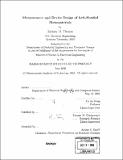Measurement and device design of left-handed metamaterials
Author(s)
Thomas Zachary M. (Zachary Michael)
DownloadFull printable version (13.02Mb)
Other Contributors
Massachusetts Institute of Technology. Dept. of Electrical Engineering and Computer Science.
Advisor
Jin Au Kong and Tomasz M. Grzegorczyk.
Terms of use
Metadata
Show full item recordAbstract
The properties of a variety of left-handed metamaterial (LHM) structures are analyzed and measured to verify consistent behavior between theory an measurements. The structures are simulated using a commercial software program and a retrieval algorithm is used to determine the effective constitutive parameters. The constitutive parameters are used to predict the behavior of the metamaterial under various configurations. Measurements are conducted to verify the presence of a negative index of refraction. Transmission through an LHM slab from several incidences is shown to be consistent with theory. A four-port device utilizing the dispersive nature of an LHM prism is designed and measured. The measurements show that the refraction angle of an incident signal is frequency dependent. Two ports are constructed to receive the positively refracted and negatively refracted power. In the frequency band where the incident signal cannot propagate in the LHM prism, the power is reflected from the interface towards a third measurement port. The three ports are shown to achieve unique mutually exclusive bandwidths. A general study is conducted on the design of such a device. Finally, the use of a left-handed metamaterial as a substrate for a microstrip line is investigated. (cont.) An LHM substrate consisting of split-ring resonators is shown to enhance the performance of a stop band filter. The measurement results are in good agreement with simulation where the substrate is modelled by its effective medium parameters.
Description
Thesis (S.M.)--Massachusetts Institute of Technology, Dept. of Electrical Engineering and Computer Science, 2005. Includes bibliographical references (p. 103-108).
Date issued
2005Department
Massachusetts Institute of Technology. Department of Electrical Engineering and Computer SciencePublisher
Massachusetts Institute of Technology
Keywords
Electrical Engineering and Computer Science.